Former Chancellor George Osborne – a man who once delivered a 15% budget cut to our national museums – has now taken up post as the Chair of the British Museum, where he claims he will bring his “experience, energy and passion” to the role. The backlash to his initial appointment, which had the Board’s unanimous backing, has been substantial.
But what the museum has not made public is that as Chair, Osborne now heads up the “Chairman’s Advisory Group” (CAG), an almost entirely unaccountable group of 30 global corporate leaders including heads of fossil fuel, arms and mining companies and investment banks, personally invited by the Chairman to offer guidance behind closed doors.
The CAG is shrouded in secrecy and few know it exists – it’s not listed on the museum’s website, the group’s membership isn’t made public and the meetings aren’t even minuted. At a time when many are calling on the museum to be more open and accountable, the CAG ensures that several controversial businesses will have ready access to the British Museum’s Chairman and Director, while legitimate stakeholder groups, from cleaners and technicians to communities with ties to the museum’s collection, often struggle to get a seat at the table.
Through our Freedom of Information (FOI) requests, we have uncovered troubling details about the role and influence of the CAG, including how:
- The membership of the CAG is dominated by controversial corporations, from the museum’s notorious oil sponsor BP to fossil banks Citi and Bank of America, and from a multinational arms company to mining giant Glencore;
- In 2020, members were invited to ‘brainstorm new ideas’ for “How the British Museum should engage with the new government?” and were sent a ‘Confidential Briefing’ document in advance, which has been heavily redacted by the museum in its response to our FOI;
- There is an almost complete absence of transparency around the CAG, with the British Museum admitting it has “no formal role within the museum’s governance structure and as such, the meetings are not minuted”;
- Members have discussed highly controversial issues such as “the repatriation debate” while the museum’s leadership repeatedly dodge the debate in public;
- Several former and current bosses from museum sponsor BP have featured among the CAG’s members, cementing the company’s influence at the top of the museum’s hierarchy. Meanwhile, the museum continues to have no formal due diligence report on the oil giant, to objectively assess its suitability as a sponsor of the museum; this should be standard practice.
This is particularly concerning as, in the wake of the covid funding squeeze, the museum is due to decide whether to renew its BP sponsorship deal for another five years in the next two to three months, based on previous timelines. George Osborne is also looking to raise £1bn towards the renovation of the museum. All this raises the question: will the museum’s most controversial sponsor, and any potential new funders, be decided upon in a transparent and ethical way or through personal ties, without proper scrutiny?
Contents
- Why a Chairman’s Advisory Group?
- Protecting big business behind a culture of secrecy
- Controversial corporates on the Chairman’s Advisory Group: arms, oil and big banks
- Chairman sought guidance on how to engage with new government but museum hides details behind redactions
- With Osborne as Chair, government and private interests entrench their influence
- Source FOI documents
1. Why a Chairman’s Advisory Group?
Businesses can and often do play a positive role in the museums sector, through partnerships and collaborations. However, issues arise when relationships are formed with unethical companies, such as arms manufacturers and fossil fuel firms, or when relationships are unbalanced and unaccountable. Then, a publicly-funded museum risks putting private interests first. As the National Audit Office highlighted in 2017, private donors and corporate sponsors, ‘may have motives other than philanthropy, for example to achieve respectability, influence or undisclosed commercial gain.’ That is why – against the backdrop of climate crisis, colonial legacies and the so-called “culture war” – the existence of the Chairman’s Advisory Group is so troubling.
Founded in 2013 by then Chair of the British Museum Niall FitzGerald, initial invitations set out how he and museum director Neil MacGregor sought “more regular input from remarkable business leaders”. At that time, museum sponsor BP was mired in controversy and legal proceedings following its Deepwater Horizon disaster in the Gulf of Mexico. However, an invitation sent to BP’s Vice President Peter Mather said it would be “a singular honour if you agreed to join this group” and that “you would bring very special experiences and perspectives”.

2. Protecting big business behind a culture of secrecy
For years now, the British Museum has come under scrutiny over its BP sponsorship deal and, by extension, its relationships with big corporations. Even now, the museum refuses to disclose how much money it receives from BP and exactly what the company gets in return. Unsurprisingly, this resistance to transparency also extends to the information the museum is willing to make public about the Chairman’s Advisory Group. Ordinarily, organisations should respond to FOI requests within 20 working days. The British Museum took over six months to respond to our FOI request.
The existence of the CAG is a relative secret – it’s referred to nowhere on the museum’s website. In contrast, the remit of the ‘British Museum’s Friends Advisory Council’ is described in detail and it includes a list of its members, their backgrounds, as well as copies of meeting minutes. In response to our FOI request about the CAG though, the museum said:

When we asked the British Museum to confirm who the current members of the CAG are, they responded:

While legitimate stakeholders of the museum often struggle to get a seat at the table, this group is granted access to the Chairman with the protection of complete anonymity. And while the members of the CAG are personally invited by the Chairman in part…

…the British Museum implausibly claims that members of the CAG attend meetings ‘at their discretion and in their personal capacity, (not as representatives of their organisations.)’

The Museums Association’s ‘Code of Ethics’ states that museums should:
‘Resist attempts to influence interpretation or content by particular interest groups, including lenders, donors and funders.’
However, the lack of transparency surrounding the CAG typifies the kind of conditions where undue influence or conflicts of interest can arise. For example, when BP’s sponsorship of the museum was renewed in 2016, the decision was taken by the Director and Chairman without wider scrutiny from the Board of Trustees. As it stands, there is no way to prove or disprove that BP, or other members of the CAG allied to BP, might have sought to influence this high-profile decision – because no records of discussions surrounding the decision or within the CAG exist.
3. Controversial corporates on the Chairman’s Advisory Group: arms, oil and big banks
Big business is well represented on the British Museum’s Board of Trustees and it’s a world that George Osborne is deeply embedded in. In fact, Osborne’s corporate ties already create one clear conflict of interest – museum sponsor BP is a client of the boutique investment bank Robey Warshaw where Osborne is a partner. He is also Chair of the Partners Council for Exor, a firm which recently bought a stake in Schlumberger, an oilfield services firm that is contracted by BP all over the world. The museum is aware of Osborne’s connections as they are already recorded in its register of member’s interests.

Also, Osborne’s former employer, the investment firm BlackRock (one of BP’s biggest investors), is represented among the museum’s trustees with the firm’s Vice Chairman Philipp Hildebrand (who recruited Osborne in 2017) and, until recently, its Non-Executive Director Sir Deryck Maughan having seats on the Board. And Minouche Shafik, who Osborne appointed as Deputy Director of the Bank of England during his time as Chancellor, led the search committee that appointed him as the museum’s new Chair.
When there are already these close personal ties on the museum’s Board, transparency around the museum’s corporate connections becomes all the more important, especially if it wants to avoid accusations of cronyism or undue influence. However, the Chairman’s Advisory Group makes the situation all the more concerning because its membership includes representatives from several highly controversial companies, often with close connections to each other or members of the Board of Trustees.
A list of CAG members disclosed to us in 2018 (before the museum decided it no longer wanted to disclose the membership) included several involved in fossil fuels and the extractive industries:
- Peter Mather, Vice President of oil and gas giant BP, the British Museum’s most controversial corporate sponsor. Despite years of delay and inaction, BP’s business plans are still not aligned with global climate goals – it plans to continue exploring for and extracting new sources of fossil fuels beyond safe limits.
- Tony Hayward, Chair of the mining company Glencore which remains heavily involved in the extraction of coal. Hayward was the CEO of BP until 2010 and at the helm at the time of BP’s Deepwater Horizon disaster in the Gulf of Mexico in which 11 workers tragically died. He is notorious for having remarked at the height of the record-breaking oil spill, “I want my life back” and was forced to step down soon afterwards.
- Iain Conn, CEO of Centrica, a domestic electricity and gas supplier – but who had originally joined the CAG as a representative of BP. He has since been ousted from Centrica after a tumultuous time running the energy supplier.
- Sir Thomas John Parker, then Chairman of Anglo American, another multinational mining company involved in coal extraction.
Alongside these fossil fuel and mining firms, there were also representatives from several major banks that have invested heavily in fossil fuels, arms and other unethical industries:
- Douglas Flint, then Chairman and CEO of HSBC, a major investor in fossil fuels which has previously faced controversy over its ongoing investments in coal extraction.
- Baroness Vadera, Chairman [sic] of Santander, known for its investments and financing of the arms industry.
James Bardrick, Head of Citi UK, which was the sponsor of the museum’s recent ‘Arctic: Culture & Climate’ exhibition. According to a report by Rainforest Action Network, Citi is the world’s third biggest funder of fossil fuels.
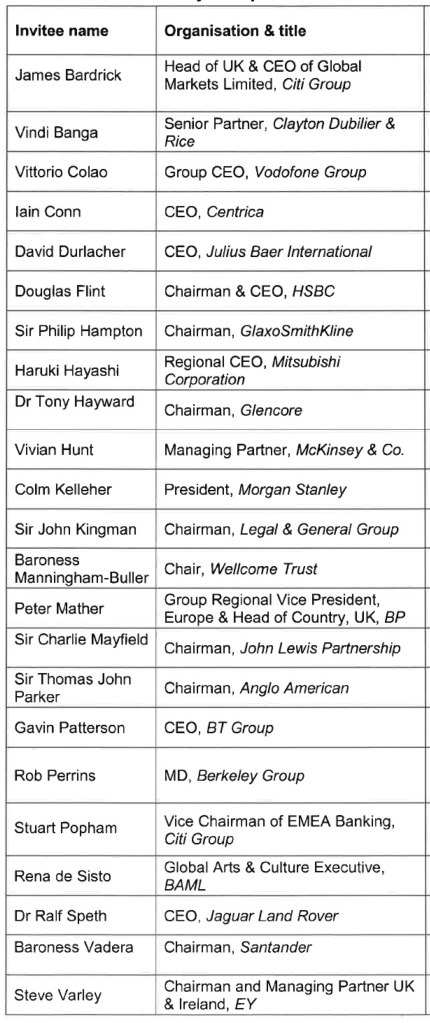
As highlighted earlier, the British Museum is now refusing to disclose the membership of the CAG entirely, thereby allowing members to keep their involvement – and any influence they exert – all but anonymous. However, the museum has disclosed to us a list setting out “the professional backgrounds of the current members of the CAG”:
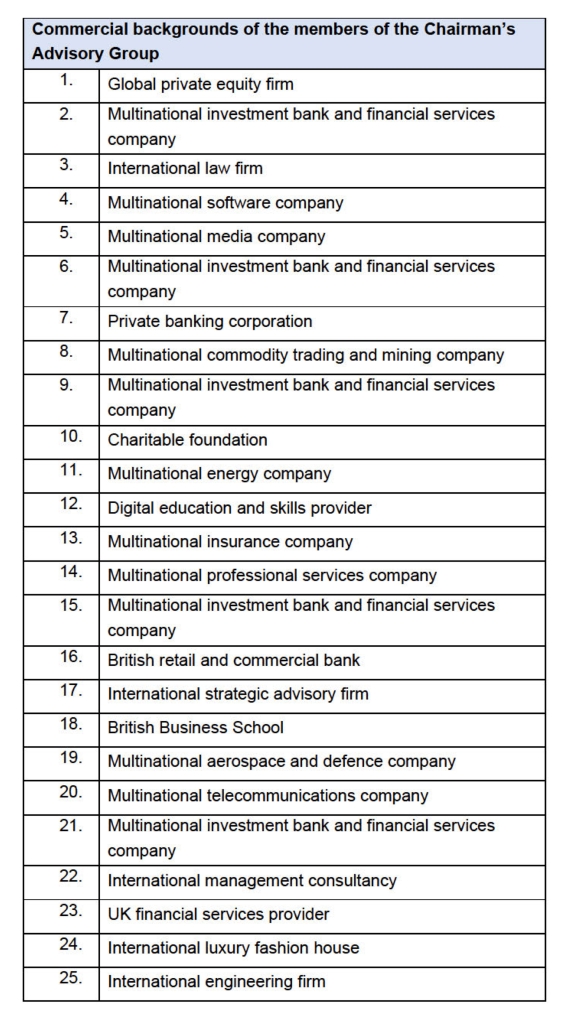

Cross-referencing the two lists suggests that many will have likely retained their membership of the CAG, including BP, Citi, HSBC and Glencore. What stands out though is the addition of a “multinational aerospace and defence company” – a synonym for an arms manufacturer.
4. Chairman sought guidance on how to engage with new government but museum hides details behind redactions
When the CAG was originally conceived under former Chair Niall FitzGerald, its status was described in the following way:

While its initial role appears to have been related to how the museum can promote and develop new corporate partnerships, over time the remit seems to have steadily shifted with members now being invited to discuss issues that form part of the museum’s core strategy. It’s also notable that in 2015-17, it was only representatives from the museum’s existing corporate sponsors BP and Citi that attended every single meeting, creating a further channel for existing corporate sponsors to cement their relationships with the museum’s leadership and exert influence.
In an invitation sent from then-Chair Richard Lambert to BP Vice President Peter Mather on New Year’s Eve 2019, he writes:

The agenda for the CAG meeting shows that after a brief tour of the ‘BP Exhibition’ Troy: myth and reality, an hour is set aside for the group to discuss how the museum should engage with the new government and to help “brainstorm new ideas”.
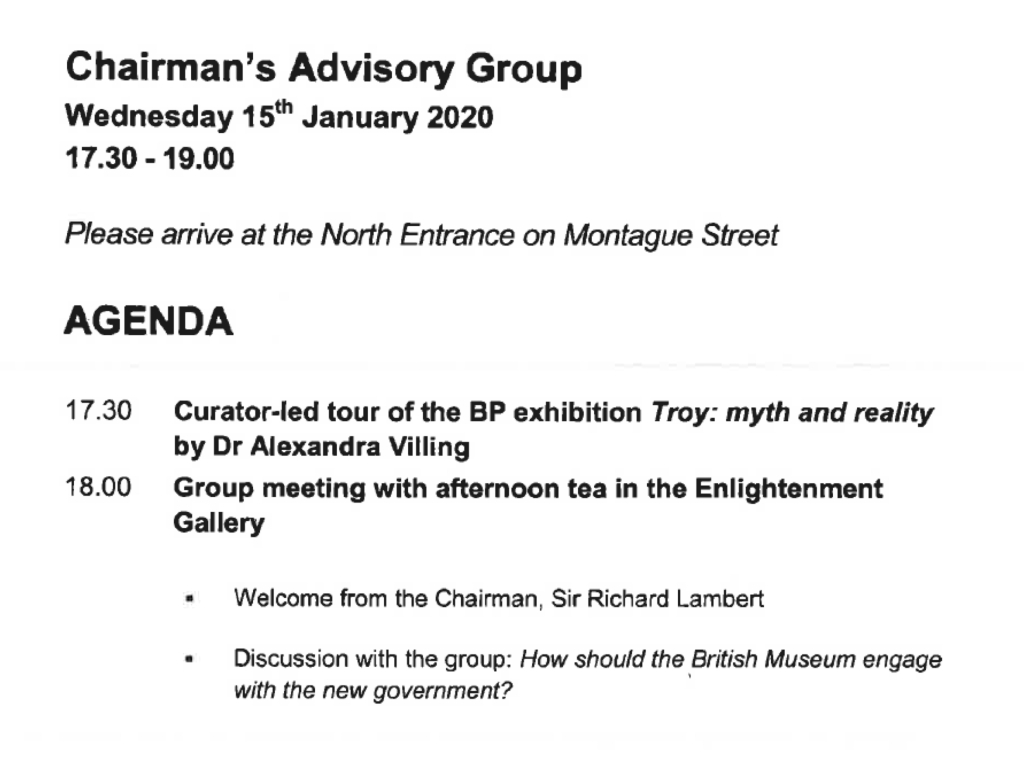
Concerningly, the briefing referred to in Lambert’s letter has been almost entirely redacted in the museum’s response to our FOI:

In its response to our FOI, the museum justifies the redaction of the briefing note, saying:

It’s concerning that a national museum which is directly funded by the government believes that disclosing the briefing note would “assist its competitors”, and raises questions about the content of the discussion. This attitude strongly contrasts with the approach in other areas of the museum’s work where the emphasis is on partnership, collaboration and co-curation:

The museum’s refusal to provide any further insight into what was discussed is an active attempt to resist transparency and we are challenging its stance with the Information Commissioner.
Once again, the list of attendees at the meeting – apart from the Director and Chairman – is entirely redacted:
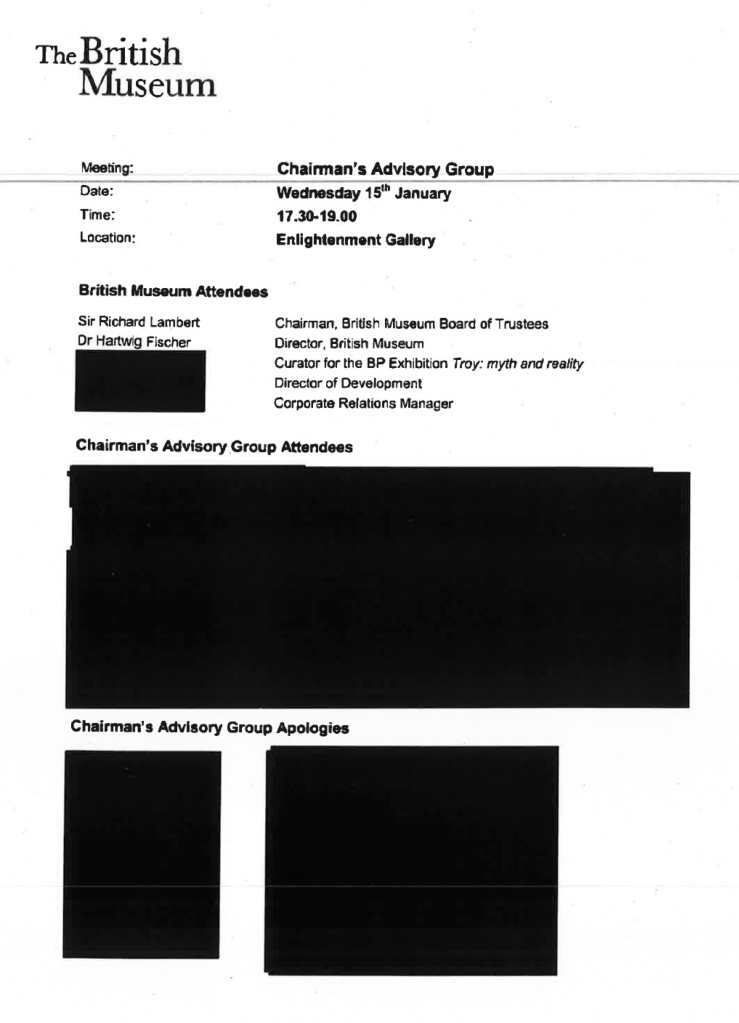
It was a few months later, in September 2020, that the trustees formed ‘The British Museum Chair Search Committee’ for identifying a successor to Richard Lambert, but these heavy redactions mean that we cannot know if ideas for potential chairs that could strengthen the museum’s relationship with government was a topic of discussion for the CAG back in January. And while the outgoing Chairman played no formal role in the recruitment process, the priorities for the new appointment will have been shaped largely over the preceding months. It was also during this period that the government began to push its stance on contested heritage – spearheaded by then-Culture Secretary Oliver Dowden – something that came to the fore for the British Museum around its decision to move and contextualise a statue of its founder, Hans Sloane into the Enlightenment Gallery.

And while the museum has claimed that the CAG is “run very informally”, Director Hartwig Fischer regularly attends and the issues the Chairman selects for discussion are often fundamental ones to the future of the museum. At a meeting in 2019, the hour-long discussion section of the meeting was dedicated to “the repatriation debate”. That meeting took place in the museum’s Enlightenment Gallery where the Gweagal Shield is currently on display, one of many objects that are currently subject to repatriation requests. Representatives from large corporations, many with their roots in Britain’s colonial past, discussing repatriation over ‘Afternoon Tea’ in the Enlightenment Gallery, with a backdrop of objects taken without permission, is beyond ironic.
When author Ahdaf Soueif resigned from the Board of the British Museum in 2019, she highlighted how a conversation she tried to start about the museum’s obligations to outsourced staff following the collapse of service provider Carillion was “shut down”. Also, when she raised the issue of BP sponsorship with the Director, Chair and Board of Trustees in 2016, she observed how:
“It was an education for me how little it seems to trouble anyone… I can only think, therefore, that the museum…does not wish to alienate a section of the business community, and that this matters more than the legitimate and pressing concerns of young people across the planet – including the schoolchildren who are a target audience for the museum.”
Given what we now know about the CAG, could this have been a factor in the museum’s resistance to her concerns and its apparent desire not to alienate a section of the business community? Had the CAG – and the corporate interests which hold a significant role on its Board – led it to prioritising corporate interests over those of the wider community it is meant to serve?

Crucially, the British Museum’s secrecy around the CAG, and particularly in relation to core issues such as repatriation and government engagement, comes into conflict with its ethical obligations. For example, as holders of public office, the Chairman and Director of the British Museum are expected to abide by Nolan’s ‘Seven Principles of Public Life’. They include:
“1.2 Integrity. Holders of public office must avoid placing themselves under any obligation to people or organisations that might try inappropriately to influence them in their work…”
And, crucially:
“1.5 Openness. Holders of public office should act and take decisions in an open and transparent manner. Information should not be withheld from the public unless there are clear and lawful reasons for so doing.”
5. With Osborne as Chair, government and private interests entrench their influence
When George Osborne’s appointment as Chair was announced on the 24th June 2021, a backlash to the decision unfolded on social media, both among those working in the culture sector as well as among the wider public. In response to our FOI request, the British Museum has also confirmed that it received a number of objections internally from members of staff and also “from external key stakeholder groups both by letter and email”.

There are also legitimate questions to be raised about Osborne’s suitability for the role. The candidate brief and role specification sets out that the Chair should have:
“Experience of chairing diverse, complex and inclusive boards, with a combination of fair-mindedness and robust decision making”
And notably:
“A deep personal interest in arts and culture, with a well-developed understanding of their role in society”

Osborne’s policies as Chancellor included a 15% cut in funding for national museums and a 30% cut to the budget of Arts Council England. From a purely objective standpoint, these policies had the effect of diminishing the role of arts and culture in society and reflected, rather than a deep personal interest, a lack of understanding about the role the sector plays.
The role specification also sets out the duties of the Chair in leading the Board of Trustees. What is striking is that Osborne is now responsible for ensuring that “conflicts on interest are managed appropriately” although he already has one such conflict himself, through his role as partner of the investment bank Robey Warshaw. Osborne also needs to ensure that, “Trustees feel able to have a free and frank exchange of views, and that all are encouraged to participate, with no individual Trustee dominating discussion.”
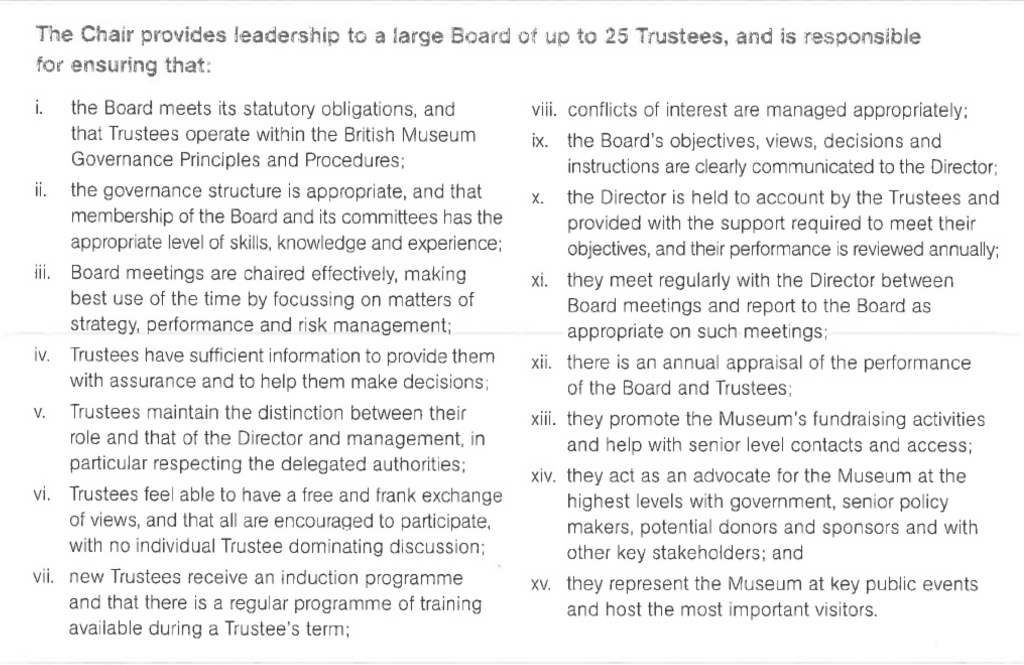
As Chair, is Osborne best placed to ensure that vital and urgent issues such as these are heard in a balanced and fair way?
Is he really best placed to manage conflicts of interests when he already has his own?
And, as he heads up the unaccountable Chairman’s Advisory Group with BP, Citi and other controversial corporations among its members, whose agenda will he be putting first when it comes to the major decisions he will inevitably have to take?
The full source documents referred to in this briefing are available to view below:
FOI response on the Chairman’s Advisory Group, December 2018
